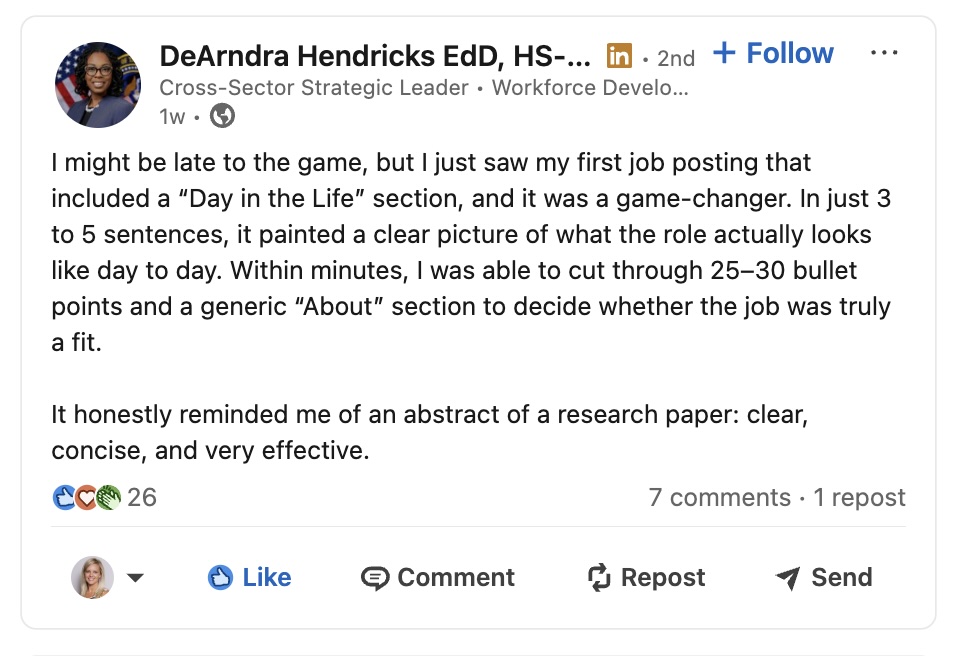- 16 Helpful Career Site Self-Service Tools for You - December 18, 2025
- Last Week I Had a Viral LinkedIn Post — But Why? (And What TA Folks Can Learn From It) - December 8, 2025
- Job Description Process Improvement: How One Workflow Fix Saved 1,200 JDs from Chaos - December 4, 2025
Some job descriptions read like a legal contract. Others read like a nap. But there’s one little section that can wake them up instantly, the “A Day in the Life” job description section. Add it, and you can turn 25 bullet points of snooze into a mental movie that hooks the right candidates.
This idea bubbled up for me after seeing a post on LinkedIn from DeArndra Hendricks, Senior Advisor and Strategist at the Office of the Director of National Intelligence. She said she spotted her first posting with a “Day in the Life” job description section and called it a game-changer. In just three to five sentences, she knew if the job was a fit, no slogging through a wall of bullets. She compared it to the “abstract of a research paper.” Short. Clear. And enough to decide if you want to read more. Genius.

My friend Kat Kibben even commented on Deandra’s post, so you know it’s worth paying attention to.
Why does the “Day in the Life” job description format work so well? Three big reasons:
- Context: Most JDs tell you what you’ll do, but not what it feels like. This fixes that.
- Clarity: A few sentences can do what 25 bullets can’t — show how the work actually plays out.
- Connection: People can see themselves in the role, which is way more powerful than a laundry list of “responsibilities.”
Think of an “A Day in the Life” job description like a movie trailer. It’s not the whole story, just enough to get you to buy a ticket.
Want to see it in action? Here’s a blurb from a real “Day in the Life” job description section from Sprinter Health’s Family Nurse Practitioner posting:
Commencing the day. Begin your day by reviewing your caseload and preparing your technology, ensuring you have all of the right tools available to service your patients.
Navigating with ease. Using easy and modern technology, you will navigate through your schedule for the day and partner with our clinical in-home team members, “Sprinters,” that will visit each patient’s home.
Creating meaningful bonds. You will have the opportunity to make a warm and welcoming connection with a diverse range of patients as you prepare to collect relevant information and perform various services.
Patient-centric wellness exam. Engage in proactive care by conducting thorough risk assessments, medication reviews, cognitive screenings, and empowering patients with educational information regarding their health and well-being.
Collaborative patient care. Work directly with Sprinters to evaluate vital signs, arrange blood draws, and carry out necessary tasks to address the specific needs of the patient.
Comprehensive care coordination and management. Provide comprehensive care coordination and management, including preventative care interventions, medication management, referrals to specialists, community resources, and documentation of findings.
You can literally see the day unfolding. Why? Because this “A Day in the Life” job description is:
- Sequential: Start to finish, no guessing what happens when.
- Active: Action verbs like “begin” and “engage” keep it moving.
- Emotional: Phrases like “meaningful bonds” and “empowering patients” make you care.
- Human: Short, simple language anyone can understand.
If I were tweaking it, I’d chop a few long sentences and simplify a couple of “complex words.” But overall? A solid “A Day in the Life” job description example.
Your Quick “A Day in the Life” Job Description Framework
- Keep it short: 3–5 sentences or 4–6 bullets max.
- Go in order: Start with how the day begins and follow the flow.
- Blend task + impact: What you do and why it matters.
- Be real: Skip the jargon and buzzwords.
- Test it: Try it in a few postings and watch the quality of applicants shift.
Pro tip: Write the “A Day in the Life” job description section first, then build the rest of the posting around it. It’ll keep you focused on what matters most for the candidate.
So here’s your challenge this week: Pick one job posting and add a “Day in the Life” job description section. Keep it human. Keep it near the top, right after your intro. And if you try it, send me your results — I might feature them in a future episode of my podcast, The JD Fix.
Big thanks to Deandra Hendricks for sparking this topic and to Sprinter Health for the great example.
Why I Wrote This
At Ongig, we believe job descriptions are marketing tools, not just compliance docs. The “A Day in the Life” job description format is one of the fastest, easiest ways to improve clarity, attract better-fit candidates, and make your postings stand out. Our job description software helps you build sections like this quickly, with templates and best practices built in. Request a demo to see how it works.
FAQs
1. Where should I put a “Day in the Life” job description section?
Right after the opening paragraph, before the list of responsibilities.
2. How long should it be?
3–5 sentences or 4–6 short bullets is ideal.
3. Can I use it for all job types?
Yes — just adjust the tone and details based on the role and industry.
4. Should it replace the responsibilities list?
No — it should complement it by giving context and personality.
5. How can I tell if it’s working?
Track applicant quality and interview-to-hire ratio before and after adding it.
